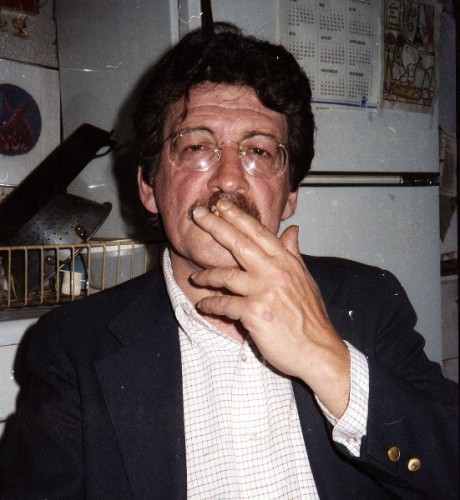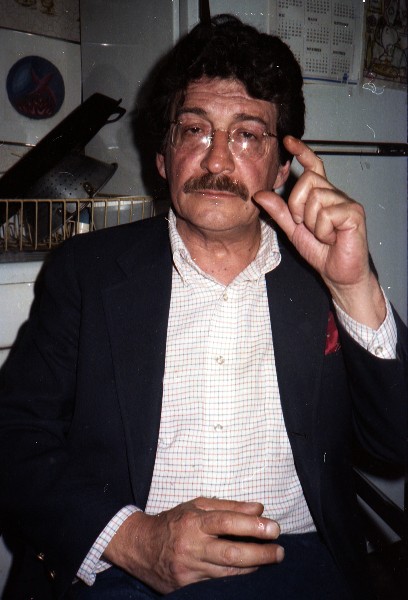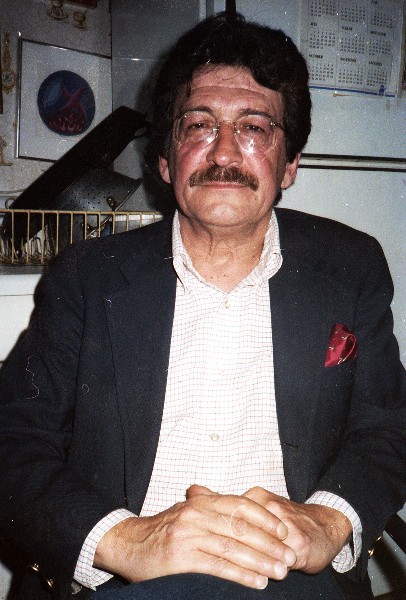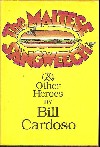Dr. Gonzo, William J. Cardoso
The Maltese Sangweech and Other Heroes
By: Charles Giuliano - Jun 04, 2014
Dr. Gonzo, my friend and colleague, William J. Cardoso (September 24, 1937 - February 26, 2006) died after a long battle with cancer of the throat. At the time I was out of town and returned to find a call on my answering machine from a Boston Globe obituary writer.
By then it was too late to comment.
Bill consorted with the criminal, hipster, lunatic fringe and often went over to the dark side. He stole the word Gonzo. I coined it while telling a raucously hilarious story in the basement living room of the Commonwealth Avenue apartment which he shared with his second wife Susan and their Afghan hounds, Suki and Sita.
Stopping me he said “What’s that you say Charles. Gonzo! What does that mean?”
Knowing that he loved baseball I put it in terms he would understand. “Over the Green Monster. Grand slam. Out of the park. Gonzo man. Total gonzo.”
Almost verbatim, in the San Francisco Chronicle obituary it is how Cardoso explained the term to a colleague “…Martin F. Nolan, who worked with Mr. Cardoso at the Boston Globe. At the time, the word was used to describe something over the top, akin to the term ‘far out’ that was used in the 1960s. A home run soaring over the wall of Fenway Park was ‘gonzo,’ said Nolan.”
At the time Bill was the editor of the Boston Globe Sunday Magazine. They had pulled him in from a happier more independent stint as New Hampshire correspondent. He had become a Globe stringer following time as a reporter for Vermont’s Valley News. They were happy days. Bill had recently married Susan Sessions a friend of mine. He got me out of bed in the North End on Easter morning and insisted I drive him to Cambridge for an introduction. He caught a glimpse of her at a party shortly after she ended a long relationship. That task done I raced to Annisquam evoking the wrath of my dad for being late to the holiday dinner.
As a Globe correspondent he covered the New Hampshire primary. Bill met Hunter Thompson and other members of the media chronicled in Boys on the Bus by Timothy Crouse. I grew up with Tim during summers in Annisquam. Tim got me the gig to replace him as rock and jazz critic for the former Boston Herald Traveler when he departed for Rolling Stone.
The true story of Gonzo has been posted in my Alvin Lee obituary. It reproduces the first published use of gonzo in my review of Ten Years After at Harvard Stadium. It’s a verifiable fact.
Reading my copy the arts editor of the Herald, Samuel Hirsch, looked at me skeptically and said “Gonzo! I’ve never heard that word.” Nervously I replied “It’s a new hip word that all the kids are using.”
He let it pass. The rest is history.
The Cardoso obituaries focus on his alleged coining of the word, connection to Hunter Thompson, and brief references to being almost famous as a gonzo journalist. It is a blessing and curse that Bill is recalled, famously, for the term which he applied to the prose of Thompson. The obits contained not much more about one of the most entertaining, complex, original, slippery writers and freebase thinkers of his generation.
Always fun to be with, no matter what was going down, Bill was not to be trusted.
It is grimly ironic that he died of throat cancer. I spoke with him a couple of times about it during bicoastal calls. His voice was harsh and hoarse as he described experimental radical treatment and surgery.
Vividly I recall him Bogarting a joint, inhaling mightily while holding his breath like a pearl diver, rocking back and forth feeling the buzz, then, and only then, passing it along in a mockery of hipster etiquette. This was always followed by a couple of unfiltered cigarettes. As he settled into reefer madness, he had a way of clasping his rimless glasses and adjusting them. Then he looked at me imperiously and intently in a serio-comic manner saying “You know Charles, you’re a glum dude.”
At the time Bill, Susie, and the hounds were crashing in my University Road, Cambridge pad having returned from a failed adventure to establish a night club in The Grand Canary Islands. It was breakfast. Then in grad school I was studying art history at the kitchen table. Smoking my gage, his favorite term for grass, he had been up all night drinking the scotch that was a house gift while entertaining our friends Jerry and Marianne Taylor. He was a former Globe colleague.
“You don’t need to go to school” he said waxing profoundly over a joint and coffee, “Just do it man. Write. That’s all you need.”
Well here I am doing just that.
Years later, our final meeting was subdued and melancholy.
By then I had moved to Line Street within walking distance of Cambridge City Hospital. He had flown in to visit his mother in the hospital and was taking a break. Over weed we caught up and shared yarns but the spark wasn’t there.
Not like during the launch of gonzo when it was gonzo this and gonzo that.
After I wrote the gonzo piece on Alvin Lee he talked Paul Szep, the inventive and razor sharp political cartoonist for the Globe, to post an image with a single word caption Gonzo. It depicted a wailing baby throwing a tantrum. There were the famous letters exchanged and published with his pal Hunter. With my blues friend Jim Silin, featuring his wife Cathy on vocals and me on drums borrowed from Barry Savenor, we performed a single gig as the Total Gonzo Band. Barry obtained the vanity plate GONZO for his Duster which was later, well, gonzo. During a party he hosted Barry pissed off one of the guests who stomped on his short.
Bill had unique ideas of what gonzo journalism should be. Each article should include a list of all the drugs and alcohol entailed in its creation. In his definition Gonzo was a total attack and immersion in the subject. He was hell bent on breaking all the rules including outing and falsifying sources. For a time there was a pact that we would all quote the ubiquitous Bob Fowler as a source. Anything that gives flavor to the literary gumbo is fair game for gonzo. Everything is on the record. Mostly the deranged author is a character in the story often more importantly than the subject at hand.
It was an anarchist assault on the establishment and the strictures of straight journalism. More and more during work days at the Heem on Morrisey Boulevard he was at odds with Globe editor Tom Winship.
Initially he was given free reign to change the Sunday magazine as he saw fit. One of his first acts was to drop the square weekly advice column Ask Beth. On Monday morning he got an angry note. It seems that, unbeknownst to Cardoso, Beth was Mrs. Winship.
Subversively Bill put hipster content into the magazine. He was particularly proud of a story on Tim Leary at West Point.
Before leaving for The Grand Canary Islands Bill told me that he was going to toss a pie in Winship’s face, quit, and storm out. The actual departure was more subdued.There was a yard sale at his sumptuous rented home in Randolph with a pool. He wondered why I didn't buy his Django Reinhardt sides but I already had them. Joining the Cardosos on their adventure was an old New Hampshire mate and fellow journalist Alec Guiselin and his wife. They parted ways when things went south.
Truth is, until recently, I hadn’t read much by Cardoso. When I knew him he was an editor and rarely wrote. Prior to that when he was a Globe New Hampshire correspondent I was living in New York.
As a journalism graduate from Boston University Bill critiqued my early writing and gave sound advice particularly about interviews. He told me that more than what they say it’s how they say it. The ambiance and how they sit in their chair was important.
Like many other Globe writers and editors at the time Bill went to Israel on a press junket. There he mostly hunkered down and smoked hash with the Palestinians. Upon returning he gave me an Arafat style head scarf and we smoked some shit he smuggled back.
Management was pissed when he refused to write about Israel. Yet another puff piece was expected.
When Humberto Sousa Medeiros was appointed Archbishop of Boston the Globe sent him to cover his birthplace in Arrifes, on the island of São Miguel, in the Azores. Bill was proud of his Portuguese heritage and described to me with great intensity the primitive conditions he encountered on that trip.
Preceding Bill as magazine editor was Ian Forman a free spirit who scandalized the Globe by wearing sandals to work. He left under complex circumstances. We became great pals at the Herald where he was co editor of education. Ian always laughed when he and Muriel Cohen regularly scooped the Globe. I often spent weekends with Ian and his huge brood in a vintage home in Ipswich. His son became a member of the rock group The Fools and we often went to see them. Ian was wonderfully subversive and we hung out with his friend Truman Nelson the author of books on John Brown. Over beers Ian told fascinating insider stories about Boston’s journalists and politicians.
Bill had a favorite dark staircase and hideout on Morrisey Boulevard where he would slip off for a midday toke. Once he stumbled on a senior Globe editor getting head from a copy boy. It was all hush hush.
Pulling the clips on Bill the obits were all the same.
The headline in the New York Times read “Bill Cardoso, 68, Editor Who Coined 'Gonzo', Is Dead.”
Douglas Martin went on to say “…A new breed of subjective journalism was christened. The idea was that a bizarre, highly personalized grapple with a situation led to truth. If drugs did not help — a minority view — they unarguably made the journey more colorful and the resulting journalism more marketable.
"Gonzo" came to describe everything from marketing to computer programming to mud-kicking country music. Google has 15.3 million references to ‘Gonzo,’ and the Oxford English Dictionary gives full credit to Mr. Cardoso.
“Not that even he knew its roots. He often said it was a corruption of the French Canadian ‘gonzeaux,' which he said connoted ‘shining path.’
“In an academic paper, titled ‘What Is Gonzo? The Etymology of an Urban Legend,’ Martin Hirst of the University of Queensland in Australia wrote that he could not find the word in French dictionaries. He offered other possibilities: a hipster expression, an Italian word for ‘simpleton’ or old South Boston slang for the last man standing after a drinking bout.
“…’It seems sad to me that all Bill's going to be remembered for is Gonzo journalism,’ Mr. (Lucian) Truscott said, explaining that Mr. Cardoso's style was more precise and restrained than Mr. Thompson's. ‘Bill may have named it, but he never wrote it.’ “
The San Francisco Chronicle stated that “’He was a bright comet,’ said Warren Hinckle, a longtime editor who hired Mr. Cardoso in the 1970s to write for a magazine he was editing for filmmaker Francis Ford Coppola, the short-lived City of San Francisco. ‘He was a damn, damn good writer. Cardoso was a god among his contemporaries, looked up to by everyone.’ ”
“Although he wrote for the influential publications of his era, including Rolling Stone, Harper's Weekly, Ramparts, and New Times, and his magazine articles were gathered in 1984 by the book publisher Atheneum for a now out-of-print anthology called ‘The Maltese Sangweech and Other Heroes,’ Mr. Cardoso didn't come close to reaching the limelight outside his tight inner literary circle.
“…But in interviews over the years, Mr. Cardoso was often sketchy about the word's origins. Sometimes he said it had French-Canadian roots, other times a Boston-Irish adjective to describe the last man standing after a drinking marathon.”
Sure I’m pissed that Bill ripped me off. But it also saddens me that his life and career has been reduced to a single boosted word.
While I kept my head down in academia, quitting reefer a month after I met Astrid twenty years ago, Cardoso walked the walk, talked the talk, and lived the life. In every sense he was Dr. Gonzo.
But different from Thompson. More like a classically trained journalist gone rogue; lost in the Heart of Darkness up the river without a paddle in search of Kurtz.
It was fascinating after all these years to read The Maltese Sangweech & Other Heroes a unique anthology which should be standard reading in every graduate program in journalism.
Truth is Bill was a slow and meticulous writer. It was difficult if not impossible for him to meet a deadline. He agonized over details particularly getting the full rich flavors of his subjects. There had to be the right chemistry between a compelling story and the editorial support and freedom to report it.
Often he complained about not getting the front money to travel and research. That is even more true today with the erosion of print, shrinking staff and budgets. As dailies close their foreign and national bureaus everyone is running the same wire feed.
During a visit to Bill and Suzie in New Hampshire he showed me a stack of tapes with a hooker from a chicken ranch near Vegas. It was research for a book that never happened. He later talked about being on the make for a big story about criminal doctor twins in Palm Springs. It would take deep pockets to develop the right upscale sources. I think it was published but I can’t track down a copy.
We were traveling when I read Sangweech one chapter per day. I like to live with a good book until the fever breaks but its delirium quickly fades.
Hunkered down with his published essays I could feel Bill in every word and nuance of thought. It was like hanging out with my old friend.
It was a slog to get into the first two pieces “The Golden Dragon Labor Day Massacre” and “Chowchilla Kidnap.” They were examples of good journalism but subjects that didn’t connect with me. Chinatown gangs in San Francisco may be interesting but nothing I will ever encounter.
He sought out odd characters and covered well trodden turf for new angles.
For “Korczak Ziolkowski” he traveled to the Black Hills of South Dakota to profile the sculptor of the yet to be completed colossal portrait of Chief Crazy Horse. Those who trek to Mt. Rushmore came to visit this nearby monument. When complete it will be 563 feet (172 m) high by 641 feet (195 m) long. Crazy Horse's head is large enough to contain all the 60-foot (18 m)-high heads of the Presidents at Mount Rushmore. The piece proves to be a compelling encounter with a colorful character seemingly as deranged as the title of his life’s work.
There would be other colorful and inventive portraits of amusingly off kilter celebrities including “The Second Coming of Monti Rock, III” “The Smothers Brothers Get their Sh-t Together” and “Evel is Dead.” It seems the motorcycle daredevil was a real putz.
He puts a twist on “The Carnival of Crusader-Quacks” and “Oregon: Sometimes a Great Nation” reworks an alleged puff piece for tourism. Seems someone sweetened the pot for him to venture that far north from more civilized Frisco. For a paid return “Singing in the Canaries” he brought along a girlfriend to visit and report on old haunts.
During a too short gig with San Francisco magazine he proposed a monthly column of restaurant reviews including the title piece "The Maltese Sangweech."
"As I have been instructed to recall" he began "smoke from my cigarette curled and drifted through the high rise studio, while I gazed down on the pleasant view of the city's soft southern slope. Memories of past assignments collected in the back rooms of my brain and were bubbling there when the phone rang. I knew the voice.
"We want you to put a cover on a couple of restaurants. We don't know what's up."
"Okay."
"Lunch at Sal's Espresso Cafe, 287 Ellis. Dinner at Ristorante Italiano, 622 Green. We want you to go eat. Take the legman. Tomorrow. Both places. Eat. Enjoy. Got it?' there was a click. The line went dead."
Overall the collection of essays is entertaining but now out of print and largely forgotten.
While damned with faint praise by the media the collection includes two absolute masterpieces of Gonzo Journalism.
During a pennant run he talked a sympathetic editor at San Francisco magazine, then with deep pockets, to front him for travel to Boston to cover the Boston Red Sox. San Francisco would adopt the team. He was then dead broke and grabbed the story by the throat in “The San Francisco Bosox.”
Bill was a passionate fan of the national pastime. While a Globe editor he had a season pass to Fenway often passing up VIP seating to hang in the nearly empty bleachers where he could light up during a game. He reveled in being surrounded by true fans.
Often he walked home after the game relating yet another loss over a late night toke. It depressed him that they were then so bad but he enjoyed the ambiance of a game. In high school he had pitched a no hitter. During visits to New Hampshire he often insisted that I join in ball games he invented in the back yard with their odd rules. He would get as stoked by this homemade field of dreams as though it was the World Series.
The piece is flat out wonderful and full of baseball language, insider information, and colorful anecdotes about sports media. Back in Boston after years on the other coast he hooked up with old friends. It seems his pal, George Kimball, the outrageous, brawling and bullying one eyed wonder of journalism, was banned from the press box. It’s an elaborate tale. Parked in the bleachers he caught opposing signs and tipped them to Louis Tiant during his twisting, 360 windup. During the series, according to Cardoso, the Sox lost because the PR manager allowed Kimball back in the press box. So Tiant and the wacko Bill Lee weren’t catching Kimball’s signs.
For the piece Cardoso did much of his research running tabs at the Eliot Lounge, a watering hole in walking distance of Fenway, and at Club Casablanca in Harvard Square. In true Gonzo style details of hanging on the road, and hilarious critical opinions of colleagues, are as much a part of the piece as the actual games.
Yet again the beloved Sox lost big time but not without memorable heroics.
The Times review brushed off Bill’s book as “a good natured romp.”
But his “Zaire” which ends the anthology is a masterpiece of Gonzo Journalism on equal footing with Thompson’s “Fear and Loathing in Las Vegas.”
Actually Thompson, a friend/ rival, also covered the George Forman vs. Muhammad Ali championship fight in the African nation of Zaire. It may have inspired Cardoso to go flat out in the greatest challenge and story of his career.
In the introduction to “Zaire” an account of the Rumble in the Jungle, one of the truly outrageous boxing matches of all time, Cardoso wrote in an introduction “Fifty Days and fifty nights in the Congo. I saw it all: Members of the High-Life band showed me a cobra in an open sewer in Zoine Lemba: a taxi driver showed me the house of the pygmy people: a man brought me the twenty-foot-long skin of a freshly killed python and was genuinely disappointed I did not buy. They showed me things and gave me things and took me places. The people did. They showed me their homes. The government, on the other hand, took things. A government official rudely stopped me one day as I passed by his table at the Inter-continental. ‘You are here to write about a boxing match not a people.’ The government took my passport and never returned it. And the government took my return plane ticket, prepaid by New Times and worth eight hundred dollars. John Daly, the copromoter, got me out the day after the fight at his own expense. They detained John Daly’s father at the airport. They detained George Forman at the airport, perhaps for losing the fight…I am convinced that the CIA chief, in the guise of an AID official, slipped me a Mickey at dinner. Verily, I believe that…”
Back in the States, trying to write the piece while ensconced at the Chelsea Hotel, a tooth fell out which he attributed to voodoo. The article he submitted was rejected as gibberish. Considering the outrageous full tilt gonzo published piece one may only speculate on the original version.
There are accounts of total mayhem including incredible interviews when he was so ripped on African ganja that he forgot to turn on the tape machine. Or notes on a sit down with Ali and a handful of reporters who stayed behind after the fight which somehow went missing. The Champ spent a couple of hours unwinding with his intimate audience. Not a word survives.
Years later he enjoyed telling tales of the Rumble in the Jungle. One of his favorite punch lines quoted Ali’s father in a tense moment telling him “We’re all niggers here.” There is a version of that in the book.
Based on the scant evidence of the Red Sox and Zaire pieces Cardoso might have been one of the truly legendary sports writers of his time. Perhaps not since the subject is always just a sidebar in vintage gonzo style.
Hunter missed the fight, or sold his tickets, and opted instead to splash in the hotel pool. I don’t think he every got his head around the story. Jungle fever.
True gonzo journalists often make up the stories they write about. Like when Kenny Greenblatt and I fled the Mar y Sol rock festival in the jungles of Puerto Rico. From a more comfortable porch in the Virgin Islands overlooking the Bay, quoting details in local papers, we phoned in a Live Report of the festival to WBCN.
Bill always said never let the facts get in the way of a story.
That’s the first rule of gonzo journalism.




